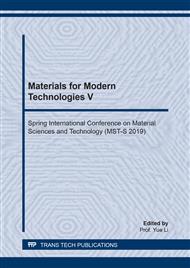[1]
Clays K. Molecular Nonlinear Optics:[J]. Journal of Nonlinear Optical Physics & Materials, 2008, 12(04):475-494.
Google Scholar
[2]
Hu G, Miao H, Mei H, et al. Two novel bi-functional hybrid materials constructed from POMs and a Schiff base with excellent third-order NLO and catalytic properties.[J]. Dalton Trans, 2016, 45(19):7947-7951.
DOI: 10.1039/c6dt00138f
Google Scholar
[3]
Yao C, Yan L K, Guan W, et al. Prediction of second-order optical nonlinearity of porphyrin-metal-polyoxometalate sandwich compounds[J]. Dalton Trans, 2010, 39(33):7645-7649.
DOI: 10.1039/c002547j
Google Scholar
[4]
Hu G, Miao H, Mei H, et al. Two novel bi-functional hybrid materials constructed from POMs and a Schiff base with excellent third-order NLO and catalytic properties.[J]. Dalton Trans, 2016, 45(19):7947-7951.
DOI: 10.1039/c6dt00138f
Google Scholar
[5]
Bulat F A, Torolabbé A, Champagne B, et al. Density-functional theory (hyper)polarizabilities of push-pull pi-conjugated systems: treatment of exact exchange and role of correlation.[J]. Journal of Chemical Physics, 2005, 123(1):B864.
DOI: 10.1063/1.1926275
Google Scholar
[6]
M. J. Frisch, G. W. Trucks, H. B. Schlegel, G. E. Scuseria, M. A. Robb, J. R. Cheeseman, G. Scalmani, V. Barone, B. Mennucci, G. A. Petersson, H. Nakatsuji, M. Caricato, X. Li, H. P. Hratchian, A. F. Izmaylov, J. Bloino, G. Zheng, J. L. Sonnenberg, M. Hada, M. Ehara, K. Toyota, R. Fukuda, J. Hasegawa, M. Ishida, T. Nakajima, Y. Honda, O. Kitao, H. Nakai, T. Vreven, J. A. Montgomery, Jr., J. E. Peralta, F. Ogliaro, M. Bearpark, J. J. Heyd, E. Brothers, K. N. Kudin, V. N. Staroverov, R. Kobayashi, J. Normand, K. Raghavachari, A. Rendell, J. C. Burant, S. S. Iyengar, J. Tomasi, M. Cossi, N. Rega, J. M. Millam, M. Klene, J. E. Knox, J. B. Cross, V. Bakken, C. Adamo, J. Jaramillo, R. Gomperts, R. E. Stratmann, O. Yazyev, A. J. Austin, R. Cammi, C. Pomelli, J. W. Ochterski, R. L. Martin, K. Morokuma, V. G. Zakrzewski, G. A. Voth, P. Salvador, J. J. Dannenberg, S. Dapprich, A. D. Daniels, Ö. Farkas, J. B. Foresman, J. V. Ortiz, J. Cioslowski, and D. J. Fox, Gaussian 09 (Gaussian, Inc., Wallingford CT, 2009).
Google Scholar
[7]
Wu H Y, Chaudhari A, Lee S L. Theoretical studies on nonlinear optical properties of formaldehyde oligomers by ab initio and density functional theory methods.[J]. Journal of Computational Chemistry, 2010, 26(15):1543-1564.
DOI: 10.1002/jcc.20294
Google Scholar


